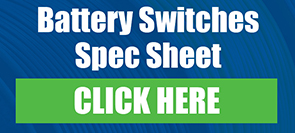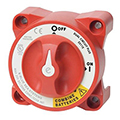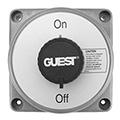Categories
- Wire & Cable
- Multi-conductor & Signal Cable
- Battery Cable Assemblies
- Terminals and Connectors
- Electrical Parts
- Electrical Tools
- ID Products
- Wire Management
- Tape & Sealant
- Mounting Panels & Panel Blanks

Need Help?
Click HereGet a Business Account
Apply HereBattery Switches
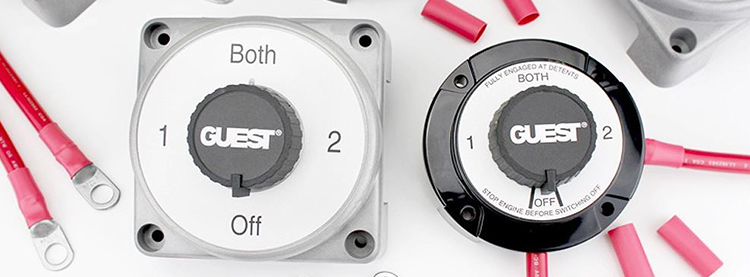
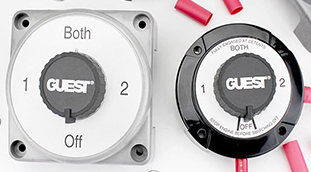
What are battery switches?
Battery switches are a type of electrical switch that is designed to be used with batteries and battery banks. Pacer carries battery switches in a variety of styles and sizes to accommodate a wide range of marine vessels. We carry Blue Seas E-Series, M-series, and more as well as Guest battery switches in a variety of styles. In this way, we offer the best options so that you are able to find the exact type of battery switch to meet your specific needs. Some battery switches can do more than just switch between battery banks such as combining battery banks.
"We offer the best options so that you are able to find the exact type of battery switch to meet your specific needs."
What safety features do battery switches offer?
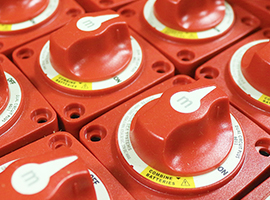
Our battery switches offer several safety features which are built into the switch body itself. For starters, these battery switches have no external conducting parts beyond the connection points. The connection points will be safely hidden whether you surface mount the battery switch or panel mount it. This is important as since they do not have external conducting parts the risk of accidental shock to an operator is greatly reduced. Another great safety feature is the fact that these battery switches isolate the battery in case of a fire. This is done to help prevent the spread of fire throughout the vessel. As a matter of fact, it is required by the ABYC that any boat with a battery over 800 cold cranking amps carry an isolating battery switch. Aside from safety features, these types of battery switches offer other advantages as well.
What advantages do battery switches offer?
Aside from the safety features we talked about above, the battery switches we carry offer a host of advantages such as advanced multi-stage charging, a durable aluminum case to prevent damage, a one-piece terminal stud designed to not loosen over time, multiple mounting options, and “make or break” contact design. All of these are advantageous in hazardous environments where other types of battery switches cannot excel. Consider the multiple mounting options. How many other battery switches give you the choice between surface mount, rear mount, or even front panel mount? The bottom line is that these switches are designed to handle the toughest environments and as such offer advantages you find elsewhere.





Where are battery switches implemented?

Battery switches are built to handle the toughest marine applications
Battery switches are implemented in marine applications where the ignition system needs a high degree of protection. One thing that makes battery switches so useful is that they allow you to isolate the battery in case of a fire. All our battery switches are ideal while installing new equipment as well as when handling replacement parts. All you will need to properly install a battery switch are the correct tools and battery cable assemblies. Just so you know, the ABYC requires that all boats with cranking amps over 800 have a battery switch onboard. Even though we touched on the basics, let us take a deeper look at where you would use a battery switch.
Where would I use battery switches?
Battery switches are designed for use in environments where you would need to switch between battery banks or combine battery banks. What sets these battery switches apart from other types is the fact that they are not only built for safety but that they are built to handle the toughest environments out there. This makes them ideal for use in the marine environment. They can be installed in a multitude of locations and are even known for their ease of installation.

What is the difference between these battery switches?
Each type of battery switch that we carry is designed with a specific application in mind. Some may be a single circuit while others may be a dual circuit. The biggest difference to pay attention to is the series. We carry the E-series, M series, Guest HD series, as well as other Guest battery switches. Below we will take a quick look at each of the different series and what separates them from the other series.
The biggest difference with the E-Series is that they are designed for use in applications that require 350 amps of continuous power. They also offer 600 amps of intermittent power. They are commonly used with small gasoline engines, outboards, or diesel engines. The E-series are known as compact high-amperage switches that offer vapor/ignition protection.
The M-series of battery switches are designed for applications that require 300 amps of continuous power. They additionally offer 500 amps of intermittent power. Similar to the E-series, the M-series is commonly used in small gasoline engines, outboards, or diesel applications. So, the main thing to consider when looking at these switches is the amperage. Pay careful attention to the needs of your specific applications.
Guest HD series of battery switches are used in applications that require either 360 amps of continuous power, 450 amps, or 600 amps depending on the type of HD series battery switch you select. Important note: some of the HD series battery switches offer AFD (alternating field disconnect) so if you are looking for a battery switch with AFD, then these are the ideal choice.
These Guest battery switches are for use in applications that call for 230 amps of continuous power. They additionally offer 345 amps of momentary power. These are clearly the battery switches designed with the lowest amperages in mind. These battery switches offer the same easy switching that comes with the other types of battery switches listed here.
Why choose Pacer?
After over forty years in the marine industry, Pacer has built a name around customer service, quality parts, and trust. We have spent decades mastering our craft. Each product that we offer undergoes a battery of tests to ensure that they are of the highest quality possible. Think about it, if we will not put it in our own personal boats, we will not sell it to you. Pacer has been trusted by some of the world's largest boat builders for decades, and for good reason.


